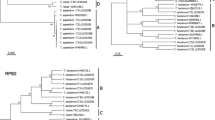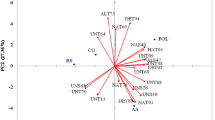Abstract
Eighteen Trichoderma strains isolated from soils of different regions of India were analyzed for their biocontrol potential against the taro leaf blight pathogen Phytophthora colocasiae. The strains were characterized using a combination of phenotypic and molecular approaches, viz., in vitro antagonism, extracellular enzyme production, ITS and tef1 gene sequencing and AFLP analysis. Eight isolates exhibited more than 75 % inhibition of the pathogen P. colocasiae. Differential antagonistic activity was evident for different strains. Assay of lytic enzyme production suggested the role of glucanase in mycoparasitism of P. colocasiae. Sequencing and phylogenetic analysis of the Trichoderma strains showed that isolates belong to three species: Trichoderma asperellum, Trichoderma longibrachiatum and Trichoderma harzianum. AFLP analysis revealed profound genetic diversity among the isolates. The most potent strain overall (TR7) identified as T. harzianum was able to control P. colocasiae in vivo also. This isolate could be used as a promising candidate for biological control of taro leaf blight disease.



Similar content being viewed by others
References
Ahmed AS, Perez-Sanchez C, Egea C, Candela ME (1999) Evaluation of Trichoderma harzianum for controlling root rot by Phytophthora capsici in pepper plants. Plant pathol 48:58–65
Anees M, Tronsmo A, Edel-Hermann V, Hjeljord LG, He’raud C, Steinberg C (2010) Characterization of field isolates of Trichoderma antagonistic against Rhizoctonia solani. Fungal Biol 114:691–701
Ashwini N, Srividya S (2013) Potentiality of Bacillus subtilis as biocontrol agent for management of anthracnose disease of chilli caused by Colletotrichum gloeosporioides OGC1 3Biotech. doi:10.1007/s13205-013-0134-4
Bartnicki-García S (1968) Cell wall chemistry, morphogenesis, and taxonomy of fungi. Annu Rev Microbiol 22:87–108
Carreiro MM, Koske RE (1992) Room temperature isolations can bias against selection of low temperature microfungi in temperate forest soils. Mycologia 84:886–900
Cohen Y, Coffey MD (1986) Systemic fungicides and the control of Oomycetes. Annu Rev Phytopathol 24:311–338
Dennis C, Webster J (1971a) Antagonistic properties of species groups of Trichoderma. I. Production of non-volatile antibiotics. Trans Brit Mycol Soc 57:25–39
Dennis C, Webster J (1971b) Antagonistic properties of species groups of Trichoderma. II. Production of volatile antibiotics. Trans Brit Mycol Soc 57:41–48
Dennis C, Webster J (1971c) Antagonistic properties of species groups of Trichoderma. III. Hyphal interaction. Trans Brit Mycol Soc 57:363–369
Druzhinina IS, Kopchinskiy AG, Komon M, Bissett J, Szakacs G, Kubicek CP (2005) An oligonucleotide barcode for species identification in Trichoderma and Hypocrea. Fungal Genet Biol 42(10):813–828
Druzhinina IS, Seidl-Seiboth V, Herrera-Estrella A, Horwitz BA, Kenerley CM, Monte E, Mukherjee PK, Zeilinger S, Grigoriev IV, Kubicek CP (2011) Trichoderma: the genomics of opportunistic success. Nat Rev 9:749–759
Edington LV, Khew KL, Barron GI (1971) Fungitoxic spectrum of benzimidazole compounds. Phytopathol 61:42–44
Etebarian HR, Scott ES, Wicks TJ (2000) Trichoderma harzianum T39 and T. virens DAR 74290 as potential biological control agents for Phytophthora erythroseptica. Eur J Plant Pathol 106:329–337
Fenice M, Gooday GW (2006) Mycoparasitic actions against fungi and oomycetes by a strain (CCFEE 5003) of the fungus Lecanicillium muscarium isolated in Continental Antarctica. Annals Microbiol 56:1–6
Fenice M, Selbmann L, Di Giambattista R, Federici F (1998) Chitinolytic activity at low temperature of an antarctic strain (A3) of Verticillium cfr. lecanii. Res Microbiol 149:289–300
Fróes A, Macrae A, Rosa J, Franco M, Souza R, Soares R, Coelho R (2012) Selection of a Streptomyces strain able to produce cell wall degrading enzymes and active against Sclerotinia sclerotiorum. J Microbiol 50:798–806
Gisi U, Cohen Y (1996) Resistance to phenylamide fungicides: case study with Phytophthora infestans involving mating type and race structure. Annu Rev Phytopathol 34:549–572
Goes LB, Costa ABL, Freire LLC, Oliveria NT (2002) Randomly amplified polymorphic DNA of Trichoderma isolates and antagonism against Rhizoctonia solani. Brazilian Arch Biol Technol 45:151–160
Haran S, Schickler H, Chet I (1996) Molecular mechanisms of lytic enzymes involved in the biocontrol activity of Trichoderma harzianum. Microbiology 142:2321–2331
Harman GE (2006) Overview of mechanisms and uses of Trichoderma spp. Phytopathol 96:190–194
Harman GE, Howell CR, Viterbo A, Chet I, Lorito M (2004) Trichoderma species- opportunistic, avirulent plant symbionts, A review. Nat Rev Microbiol 2:43–56
Hermosa MR, Grondona I, Iturriaga EA, Diaz-Minguez JM, Castro C, Monte E, Garcia-Acha I (2000) Molecular characterization and identification of biocontrol isolates of Trichoderma spp. Appl Environ Microbiol 66:1890–1898
Howell CR (2003) Mechanisms employed by Trichoderma species in the biological control of plant diseases: the history and evolution of current concepts. Plant dis 87:4–10
Jaklitsch W, Samuels G, Dodd S, Lu B, Druzhinina I (2006) Hypocrea rufa/Trichoderma viride: a reassessment, and description of five closely related species with and without warted conidia. Stud Mycol 56(1):135–177, ISSN 0166-0616
Jeffries P, Young TWK (1994) Interfungal parasitic relationships. CAB International, Wallingford, United Kingdom, p 296
Klein D, Eveleigh DE (1998) Ecology of Trichoderma. In: Kubicek CP, Harman GE (eds) Trichoderma and Gliocladium, vol 1, Basic Biology. Taxonomy and Genetics. Taylor and Francis Ltd., London, pp 57–74
Kullnig CM, Krupica T, Woo SL, Mach RL, Rey M, Benitez T, Lorito M, Kubicek CP (2001) Confusion abounds over identity of Trichoderma biocontrol isolates. Mycol Res 105:769–772
Lambert DH, Salas B (1994) Metalaxyl insensitivity of Phytophthora erythroseptica isolates causing pink rot of potato in Maine. Plant Dis 78:1010
Lebot V, Herail C, Gunua T, Pardales J, Prana M, Thongjiem M, Viet N (2003) Isozyme and RAPD variation among Phytophthora colocasiae isolates from South East Asia and the Pacific. Plant Pathol 52:303–313
Mantel N (1967) The detection of disease clustering and generalized regression approach. Cancer Res 27:209–220
Migheli Q, Balmas V, Komoñ-Zelazowska M, Scherm B, Fiori S, Kopchinskiy AG, Kubicek CP, Druzhinina IS (2009) Soils of a Mediterranean hot spot of biodiversity and endemism (Sardinia, Tyrrhenian Islands) are inhabited by pan-European, invasive species of Hypocrea/Trichoderma. Environ Microbiol 11(1):35–46
Misra RS, Sharma K, Mishra AK (2008) Phytophthora leaf blight of Taro (Colocasia esculenta) – a review. Asian Austral J Plants Sci Biotechnol 2:55–63
Moenne-Loccoz Y, Tichy H, O’Donnel A, Simon R, O’Gara F (2001) Impact of 2,4-Diacetylphloroglucinol producing biocontrol strain Pseudomonas fluorescens F113 on intraspecific diversity of resident culturable fluorescent Pseudomonads associated with the roots of field-grown sugar beet seedlings. Appl Environ Microbiol 67:3418–3425
Molano J, Duram A, Cabib E (1977) A rapid and sensitive assay for chitinase using tritiated chitin. Anal Biochem 83:648–656
Mpika J, Kébé IB, Issali AE, N’Guessan FK, Druzhinina S, Komon-Zélazowska M, Kubicek CP, Aké S (2009) Antagonist potential of Trichoderma indigenous isolates for biological control of Phytophthora palmivora the causative agent of black pod disease on cocoa (Theobroma cacao L.) in Côte d’Ivoire. African J of Biotechnol 8(20):5280–5293
Nath VS, Senthil M, Hegde VM, Jeeva ML, Misra RS, Veena SS, Raj M (2012a) Evaluation of fungicides on Indian isolates of Phytophthora colocasiae causing leaf blight of taro. Arch Phytopathol Plant Prot http://dx.doi.org/10.1080/03235408.2012.749688
Nath VS, Senthil M, Hegde VM, Jeeva ML, Misra RS, Veena SS, Raj M (2012b) Genetic diversity of Phytophthora colocasiae isolates in India based on AFLP analysis. 3 Biotech. doi:10.1007/s13205-012-0101-5
Nath VS, Senthil M, Hegde VM, Jeeva ML, Misra RS, Veena SS, Raj M (2013) Molecular evidence supports hypervariability in Phytophthora colocasiae associated with leaf blight of taro. Eur J Plant Pathol. doi:10.1007/s10658-013-0181-z
Nei M, Li WH (1979) Mathematical model for studying genetic variation in terms of restriction endonucleases. Proc Natl Acad Sci U S A 76:5269–5273
Saitou N, Nei M (1987) The neighbor-joining method: a new method for reconstructing phylogenetic trees. Mol Biol Evol 4:406–425
Samuels GJ (2006) Trichoderma: Systematics, the sexual state, and ecology. Phytopathol 96:195–206
Scherm B, Schmoll M, Balmas V, Kubicek CP, Migheli Q (2009) Identification of potential markers for Trichoderma harzianum strains with high antagonistic potential against Rhizoctonia solani by a rapid subtraction hybridization approach. Curr Genet 55:81–91
Schuster A, Schmoll M (2010) Biology and biotechnology of Trichoderma. Appl Microbiol Biotechnol 87:787–799
Sharma K, Mishra AK, Misra RS (2009) Morphological, biochemical and molecular characterization of Trichoderma harzianum isolates for their efficacy as biocontrol agents. J Phytopathol 157:51–56
Sivasithamparam K, Gisalberti EL (1998) Secondary metabolism in Trichoderma and Gliocladium. In: Kubicek CP, Harman GE (eds) Trichoderma and Gliocladium Basic Biology. Taxonomy and Genetics. Taylor and Francis Ltd., London, pp 139–191
Tamura K, Peterson D, Peterson N, Steker G, Nei M, Kumar S (2011) MEGA5:Molecular evolutionary genetics analysis using maximum likelihood, evolutionary distance, and maximum parsimony methods. Mol Biol Evol 28:2731–2739
Van de peer Y, Dewachter R (1994) Treecon for Windows—a software package for the construction and drawing of evolutionary trees for the Microsoft Windows environment. Comput Appl Biosci 10:569–570
Vinale F, Sivasithamparam K, Ghisalberti EL, Marra R, Woo SL, Lorito M (2008) Trichoderma-plant-pathogen interactions. Soil Biol Biochem 40:1–10
Weller DM (2007) Pseudomonas biocontrol agents of soilborne athogens: Looking back over 30 Years. Phytopathol 97:250–256
White TJ, Bruns T, Lee S, Taylor JW (1990) Amplification and direct sequencing of fungal ribosomal RNA genes for phylogenetics. In: Innis MA, Gelfand DH, Sninsky JJ, White TJ (eds) PCR protocols: a guide to methods and applications. Academic, New York, pp 315–332
Zaldívar M, Velásquez JC, Contreras I, Pérez LM (2001) Trichoderma aureoviride 7-121, a mutant with enhanced production of lytic enzymes: its potential use in waste cellulose degradation and/or biocontrol. Electronic J Biotechnol 4(3):1–9
Zhang LJ, Yang XK, LiwZ CJZ (2005) A new record of Ophraella communa of mainland China. Chin Bulletin Entomol 42:227–228
Acknowledgments
The funding provided for conducting the research work by the Indian Council of Agricultural Research, New Delhi, under IISR outreach programme is gratefully acknowledged. Thanks are due to Mr. Ragesh, Ph.D scholar, CTCRI for his assistance in statistical analysis. The authors wish to thank the editor and the reviewer for their valuable comments in improving the manuscript.
Author information
Authors and Affiliations
Corresponding author
Rights and permissions
About this article
Cite this article
Nath, V.S., John, N.S., Anjanadevi, I.P. et al. Characterization of Trichoderma spp. antagonistic to Phytophthora colocasiae associated with leaf blight of taro. Ann Microbiol 64, 1513–1522 (2014). https://doi.org/10.1007/s13213-013-0794-7
Received:
Accepted:
Published:
Issue Date:
DOI: https://doi.org/10.1007/s13213-013-0794-7




